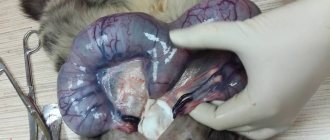Optimal age for intervention
Animal lovers often wonder whether it is possible to sterilize a cat while walking. It's best to do this as early as possible. For example, recommended age:
- 8 months;
- 10 months;
- 1 year;
- 1.5 years.
Babies easily tolerate sterilization, complications are rare
By completing the procedure at eight months, the owner is guaranteed to solve the problem of unwanted pregnancy once and for all. However, animal owners are often afraid that too early intervention can harm the fragile body. These fears are unfounded. If the cat is healthy, no problems should arise. The main thing is to follow all the recommendations of the attending veterinarian.
Important! Difficult childbirth is much more dangerous for a young female.
The younger the animal, the easier it will tolerate the effects of anesthesia.
Favorable age
The opinions of Western and Russian veterinary experts on this matter differ. Domestic doctors believe that sterilization should be carried out between the ages of six months and one year.
Foreign veterinarians recommend doing this at the age of 3 months, arguing that this way the animal will develop more harmoniously. Domestic experts advise against doing this, since the organs need to be allowed to fully develop before sterilization is carried out.
If the animal will participate in regular breeding, then sterilization is carried out at the age of 5–7 years.
It must be remembered: the younger the animal, the easier it tolerates operations and the easier the rehabilitation period.
Is it possible to spay during heat?
Estrus is the period when an animal:
- Begins to actively mark the territory.
- She asks to be let out into the street. At this time, even the most domestic cats have a good time walking.
- Waits for intimacy with the male.
- Feels increasing sexual arousal, prepares to become pregnant and give birth.
Is it possible to spay a dog while in heat?
Owners often try to schedule sterilization at this particular time. However, this theory has many opponents.
Veterinarians' opinions
When asked whether it is possible to sterilize a cat during heat, experts answer differently. Most specialists give a negative answer, because at this moment there is a high risk of hemorrhages during surgery and hormonal imbalances in the postoperative period. However, a qualified surgeon minimizes all risks.
Important! Performing an operation once in a lifetime is much safer than risking the health and life of your pet during childbirth every year.
Is it possible to have surgery after the first heat?
Of course, it is advisable to carry out the operation before the animal shows signs of puberty.
The optimal age for sterilizing an animal, when this operation is as safe as possible, is 6-8 months. By this time, the cat is already fully formed, the genitals are developed, but there are still no signs of maturation.
The first heat - the period of puberty for an animal represents a stressful situation when the pet begins to behave inappropriately, screams loudly, rushes outside, and marks the territory.
Reference!
There are often cases when surgery performed after estrus does not bring the desired result, and the cat periodically continues to behave inappropriately, for example, marking its territory.
This is due to the fact that not only the animal’s ovaries produce hormones, but also the pituitary gland, which continues to synthesize them into the brain.
It is for this reason that all veterinarians believe that the best period for sterilization is before the animal reaches puberty. This approach will allow you to control your cat's behavior.
Possible risks
How to calm a cat - options during heat and when she's mad
If the veterinarian answers positively to the question whether it is possible to sterilize a cat during heat, he is obliged to explain to the owner all the possible risks:
- Significant enlargement of the uterus makes it difficult to remove it correctly from the animal’s body.
- Sterilization and estrus can greatly impact the immune system if the animal is initially weakened or has chronic diseases.
If the procedure is carried out during estrus, it can provoke an exacerbation of gynecological diseases in the cat.
Surgery during estrus is not advisable
Is it acceptable to sterilize a cat during the mating season?
When the reproductive instinct manifests itself, many cats meow loudly, sleep poorly, and behave aggressively. To restore peace of mind to themselves and their furry pet, the owners turn to the veterinarian with a request to perform an operation that would interfere with the functioning of the animal’s reproductive organs.
Official medicine refers to sterilization as ligation of the fallopian tubes. But in everyday speech this is what is called the complete removal of the cat’s uterus and appendages.
Experts are divided on whether it is possible to sterilize a cat during heat. But most representatives of veterinary medicine argue that a highly qualified doctor will cope with this task perfectly. They refute common beliefs associated with the impossibility/inexpediency of this operation and its negative consequences:
- removal of an enlarged uterus is impossible
Indeed, during estrus, the cat's uterus increases in size, and the diameter of the vessels that supply this organ with blood also increases. But the veterinarian must be able to ligate large vessels and perform operations on the enlarged genital organs of the animal, because sometimes surgical intervention is necessary even during pregnancy (for example, in the event of a threat of intrauterine death of the offspring and other pathologies);
- there is a risk of hormonal imbalance
After removal of the ovaries, the hormonal background of the cat will definitely change, no matter what condition it is in. How does her body manage to cope with such changes? The adrenal glands, pituitary gland and thyroid gland of the animal do an excellent job of regulating hormonal balance;
- the cat will retain instinctive needs that were activated when reproductive function was interrupted
Animals are not aware of the nature of their instincts, so “love time” for furry pets is not associated with a psychological state. Their behavior is triggered by hormonal changes, and once the organs that produce sex hormones are removed, the cat will become peaceful again.
Note! Hormonal contraception is much more dangerous to the health of cats during estrus than surgery.
However, is everything so optimistic (especially considering the difference in approach)? Can we say that the risks of bleeding and other complications are still higher if the cat had to be sterilized when it “requires a groom”? Yes, there is a risk of harming your pet, especially in the event of a medical error. Therefore, it is best to schedule surgery 5-6 days after the end of estrus.
In addition to the question of the possibility of removing the genital organs of cats during heat, their owners also raise other topics related to such an operation. Let's look at some of them.
- When to do this, is it possible to sterilize a cat, for example, at 1 year, at 3 years, at 5 years?
Experts recommend refusing to sterilize pets that have not reached 8 months of age, since the body of such animals is not yet fully formed. But veterinarians do not name the upper age limit at which the procedure for removing reproductive organs is permitted. If a pet, whose age is measured not in months, but in years, is healthy and tolerates the drugs used during surgery well, there are no contraindications to sterilization.
- The cat gave birth - is it too late to sterilize?
Is it possible to sterilize a cat if she has not given birth? There is an opinion that a pet's body will be weak if it never becomes a mother. But this point of view has no scientific confirmation. Is it possible to sterilize a cat after the first birth? Yes, but it must be done correctly so as not to harm your pet. If a four-legged mother is nursing her offspring, the operation should be performed 2-3 months after birth, and only 2 weeks after the kittens have stopped feeding on her milk. If for some reason they did not survive or are bottle-fed, the cat can be sterilized within a month after birth. During this period, the functioning of her body returns to normal.
- In what cases is it possible to sterilize pregnant cats?
It would seem obvious that the destruction of gestating offspring and the traumatic nature of surgical intervention are very compelling arguments in favor of a ban on sterilization of pregnant cats. But sometimes a pet who is expecting babies becomes so ill that her alarmed owners take her to the veterinary clinic, where it is discovered that without termination of pregnancy the cat will die. Of course, in such a situation a decision will be made about surgical intervention. It is very reasonable if during the operation the doctors also remove the uterus and appendages: the animal will not have to endure postoperative suffering twice and be at double the risk of complications.
For most cats, the period of estrus occurs quite violently. The animal becomes nervous, eats poorly, begins to meow loudly and mark its territory, loses weight, and sometimes shows aggression or, conversely, begins to show excessive affection. This behavior begins a few days before this period. The duration of the heat itself lasts approximately a week. Not every owner is able to withstand such pet behavior. If the animal is not planned to be used for breeding, then it can be castrated. However, the period of estrus is not the best time for sterilization.
“Standard” sterilization during estrus
The standard procedure for removing the uterus is carried out in all veterinary clinics. Proper preparation reduces all risks to a minimum. It is recommended to begin preparations at least two weeks before the intended sterilization.
Preparing for surgery
Is it possible to spay a pregnant cat early or late?
To properly prepare your pet for medical intervention, you must:
- take blood tests;
- take a general urine test;
- undergo an examination by a cardiologist and do an ECG (especially if the animal is 7-8 years old);
- do an ultrasound (according to indications).
If any abnormalities are detected, the operation will be delayed.
Attention! Before carrying out the manipulation, it is necessary to carry out unscheduled treatment against worms and vaccination against rabies. Data about these procedures are entered into the animal’s veterinary passport. Without this information, the cat may not be allowed on the operating table.
Technique
You can castrate a female in the first two days after the start of estrus. An incision is made in the animal's abdominal cavity, the uterus is excised and removed, and then stitches are applied. After this manipulation, the cat will need to wear a blanket for a long time to prevent infection of the stitches.
Postoperative period
After sterilization, the owner’s main task is to provide the cat with peace and not let it go outside. Also, the animal should be protected from sudden changes in temperature and fed moderately, because heavy food can cause vomiting.
After surgery, your pet may feel chills or nausea
Attention! After surgery, the animal may behave aggressively or, conversely, lethargically.
This is how the delayed effect of anesthesia manifests itself. There is no need to worry - this phenomenon passes quickly.
Sterilizing a cat: the best time to perform the operation, when?
Sterilization is common and easy to perform; complications after it are extremely rare.
Sterilization is carried out under anesthesia, using special preparations for cats, during which the animal’s eyes remain open. The effect of anesthesia on a cat’s body will not harm its health if the dosage is calculated correctly. It depends on the weight of the animal and the individual characteristics of its body. After the operation, the animal, while it is still under anesthesia, must be placed in a warm place. It is advisable to lay it on its side and place a heating pad next to it. At the same time, you cannot put her on an elevated place, because after anesthesia she has poor control of her movements and may fall and get injured.
After the operation, the animal will not eat, and there is no need to force it, but drinking water must be provided.
You need to try feeding the next day; you should give wet food in small portions. There are special foods for the postoperative period that have a positive effect on the functioning of the digestive tract.
To prevent the animal from licking the seams and damaging them, it is necessary to put a special collar on it, which is removed only during feeding. Immediately after the operation, the pet must be taken home as quickly as possible and wrapped up, because under anesthesia their body temperature drops. It is also necessary to turn it over every half hour from one side to the other, and close your eyes so that they do not dry out. It is necessary to constantly monitor him and show him the care that he really needs now.
A sterilized cat becomes calmer and interacts with other animals without aggression. After sterilization, animals become more focused, make more contact with the owner, and are better trained.
After sterilization, animals' activity decreases, but their appetite increases. In order to avoid obesity, it is necessary to feed your pet with special food for sterilized cats. It is also worth playing with him more so that he does not become lazy.
Sterilization allows you to get rid of many behavioral problems and reduce the risk of tumors, while animals tolerate the operation without any difficulties. With a properly performed operation and subsequent care, she will return to her previous life within a few days.
It is possible to sterilize a cat both young and adult. However, the type of its implementation will directly depend on the age at which such a procedure will be performed. It is of course better to castrate and sterilize an animal when it is young, since during the surgical procedure the veterinarian will only remove the ovaries.
In the case of an adult, the situation is somewhat aggravated, and during the operation not only the ovaries, but also the uterus itself will be removed. As for the optimal period for operating on a female, it is best to carry out the manipulation at a time when the body is fully formed, but the first heat has not yet occurred.
READ Is it possible to feed chickens bread - useful tips
When is the best time to spay a cat?
The ideal time for intervention is when the first heat has passed. This time may vary for different breeds. For some, puberty occurs as early as six months, while for others, not earlier than 10 months.
Before the first heat: laparoscopic and standard sterilization
If you want to perform the operation as quickly as possible, without waiting for the first cycle, it is better to choose the laparoscopic method. A puncture is made in the abdominal cavity, a probe with video sensors is inserted into it, the ovaries are excised and the seams are sealed without suturing them. Within 2 hours after the intervention, the animal can walk; it is not necessary to wear a blanket.
Important! The standard method is more painful, and it is harder for the animal to recover, because this method involves making an incision in the abdominal cavity.
Sterilization after estrus, when to start
If the first heat has just ended, it is better to plan surgery about a week after the final end of this period. During this period, hormonal levels stabilize, so the animal tolerates medical intervention well.
Myths and reality about sterilization
When making a decision to deprive a pet of reproductive function, the following beliefs must be taken into account:
- After sterilization, a cat becomes inferior - it is worth saying again that animals cannot dream of offspring, they do not even understand what happens to them during pregnancy, childbirth, before castration and after. Cats act instinctively, and sterilization is a humane procedure that does not in any way affect the mental state of the animal.
- The cat should be allowed to give birth once so that she feels like a mother - pregnancy cannot be for the benefit of the animal, and this should not be allowed on purpose, especially if the pet has health problems. Pregnancy and childbirth are a serious burden on the body and severe stress.
- After sterilization, the cat will become lazy and sleep a lot - this aspect can appear, but only if the owner does not pay enough attention to it. If a cat purrs, screams or marks after surgery, then you cannot do without consulting a specialist.
- Urinary incontinence appears - this scourge is more dangerous for dogs than for cats, with a statistical probability of less than 5%.
- Sterilization leads to a shorter life span of the animal - this is not true, because the operation allows you to adjust hormonal levels, stabilize the general condition, and eliminate stress factors associated with pregnancy and childbirth. As a result, life expectancy not only increases, but also becomes better.
- After sterilization, a cat stops hunting - the hunting instinct is not related to the reproductive instinct, so even after surgery the animal will clear the area of rodents.
In order for the castration process to go smoothly, it is important to follow the recommendations of a specialist, follow the rules of caring for your pet, feed it with quality food, and set aside time for entertainment.
Castration of a cat is a humane and safe method; the main thing is to carry out the procedure by an experienced veterinarian, then even the operation during the period of estrus will not pose a threat to the health of the animal.
Benefits of sterilization
Removing a cat's uterus surgically has many benefits, such as:
- protection from unwanted offspring;
- increasing the life expectancy of the animal;
- improving the cat's character;
- normalization of hormonal levels.
But most importantly, the cat will begin to behave calmer and will not ask to go for a walk. This is especially important for owners who keep pets in large cities, where pets cannot be left unattended for a long time.
In order for the animal to safely undergo castration, the cat must be properly prepared for medical intervention. This will help avoid serious postoperative complications and psychological stress. If everything went well, the cat needs a good gentle regimen for at least a month. Then she will quickly regain her physical strength and finally recover.
Caring for a cat after sterilization
Even before the operation, you need to prepare a place for “rehabilitation”. Take a medium-sized box, cut it so that the cat can easily climb in/out, cover it with a soft cloth and place it in a secluded, warm place.
The first day after sterilization, the cat will mostly sleep. Create a calm and peaceful environment for her. Seams, if any, must be treated daily with brilliant green and hydrogen peroxide.
Do not force your cat to eat; drinking plenty of fluids will suffice. After 24 hours, the cat will begin to eat on its own, after a week it will begin to move and return to its normal state immediately after the stitches are removed.
If you see that your pet is unwell, she is breathing heavily or her stitches are inflamed, consult a doctor immediately.
Estrus, pregnancy and childbirth
Not all owners understand the relationship between the reproductive and reproductive systems. Because of this, it is completely unclear when to spay a cat: before, during or after heat. Even more difficulties arise with the need for childbirth. Many owners mistakenly believe that deprivation of reproductive function is safe only after bearing at least one litter.
Surgery is permissible if the pregnancy is no more than 1 month. Otherwise, there is a possibility of increased blood loss and a prolonged postoperative period. Intervention is also permissible in case of abnormal fetal development, poor health or old age, which prevents the safe bearing of kittens. In all other cases, the operation is postponed until complete postpartum recovery.
We suggest you familiarize yourself with gag reflexes in cats, symptoms of vomiting and its causes.
After giving birth, a young mother needs 2-3 months to fully recover. During this time, the uterus returns to its original size, and blood circulation in the pelvis is normalized.
Emergency intervention immediately after the birth of kittens is practiced when:
- detection of tumors in the reproductive organs;
- the presence and high probability of postpartum hemorrhage;
- uterine rupture;
- damage or abnormalities of the placenta.
In these situations, the risk of possible complications is higher than the risks associated with sterilization. The procedure is considered justified.
The most popular question arising from the baseless myth about the “joy of motherhood.” From a psychological point of view, animals are not subject to emotions and act instinctively. The absence or presence of pregnancy is taken for granted by them, and therefore does not have a fundamental impact on their lives.
An obvious logic appears when considering the issue from a biological point of view. Before pregnancy, female sex hormones (estrogens), responsible for sexual desire, are produced by the ovaries. If they are removed in a timely manner, the animal loses not only the ability to conceive, but also interest in the opposite sex.
Otherwise, other internal secretion organs are involved in the production of estrogen. As a result, the operated pet will not be able to become pregnant again, but will continue its loud rituals of calling cats. If you do not want to endure such concerts for the rest of your furry pet’s life, do not allow mating until sterilization.
In addition to the high risk of retaining some sex hormones, pregnancy reduces the effect of the procedure. The probability of developing cancer after the first birth is 8%, and after the second it increases by more than 3 times.
During estrus, hormonal changes occur. Any intervention is fraught with multiple complications, including the development of oncology. Due to the dilation of blood vessels, there is a high probability of heavy blood loss. Animals recover from anesthesia worse and have a more difficult time experiencing the postoperative period.
It is safer to carry out surgery 2 weeks before or after estrus, when the pet’s condition returns to normal. Exceptions include prolonged heats with a short interval between them. They impair quality of life and lead to exhaustion. In this case, the animal is sterilized for medicinal purposes.
Sterilization or castration?
The most common term you hear is “sterilization.” The procedure involves ligating the fallopian tubes. This method gives a good contraceptive result, but the estrus instinct does not disappear and estrus does not stop.
Castration is the complete removal of the organs of the reproductive system (ovaries or ovaries and uterus). The latter option is more preferable, as this will be the future prevention of cancer.
To stop estrus forever, the animal must be castrated. After removal of the ovaries, hormonal regulation is taken over by the pituitary gland and adrenal glands.
The operation is performed in a clinic under sterile conditions, which minimizes the risk of possible complications.
What age is optimal for sterilization?
The most favorable period for the operation is the 7-10th month of life. Older cats tolerate surgery normally, but older cats, 10 years of age and older, may not survive the procedure.
If the owner of a mature cat wishes to undergo sterilization, a comprehensive examination must be carried out before the operation, based on the results of which the doctor will be able to determine postoperative risks.
If the veterinarian recommends refusing the procedure, considering the potential threat to her life and health, we advise you to listen to the opinion of the specialist and refuse the planned intervention.
So, now you definitely know the answer to the question - is it possible to sterilize a domestic cat in heat, and we hope our article will help you make the right decision for this procedure!
Abyssinian cat - coat colors and eye colors
A cat that looks like a leopard - what do spotted breeds look like?
American Maine Coon and European - differences between species
How to distinguish a Maine Coon kitten from a regular one and a mixed breed - signs of the breed
Large size scratching post for Maine Coon
Names for Maine Coon boys and girls - how to name a cat
Postoperative period
The postoperative period takes place at home. The sterilization procedure involves cutting into the abdomen, so recovery can be lengthy and painful.
The pet wears a special bandage for 1-2 weeks after the procedure. Hyperactive individuals are given a collar that prevents the animal from scratching and licking the seams.
For 7 days after completion of sterilization, it is recommended to give the animal liquid food so as not to burden the digestive organs, as well as to drink plenty of clean water.
You should protect your pet from playing with children and other activities so that the seams do not come apart. The seams should be wiped once a day with a solution of Miramistin or Chlorhexidine.
The procedure of sterilization and castration can be difficult for a pet, so it is necessary to provide him with peace and comfort during rehabilitation.
Sterilization - what kind of operation is it?
When spaying cats, veterinarians may remove only the ovaries or the ovaries along with the uterus. This type of surgery is performed under general anesthesia, so owners should not worry that the pet will experience pain.
Anesthesia is administered twice: the first time in order to calm the animal, and the second is mandatory directly for carrying out a painless and fairly simple strip operation.
Preparation is the most important stage
Before contacting the clinic, owners must independently prepare the animal for such an important event:
- on the eve of the operation there is no need to feed the animal; the pet can eat its last meal approximately a day before the appointed time;
- when transporting to a veterinary clinic, you should try to calm your furry friend by gently stroking him and speaking kind words;
- It is imperative to obtain information about the necessary medications that may be required during surgery in order to purchase them in advance.
Abdominal surgery lasts approximately 40-45 minutes; To prevent the animal's cornea from drying out, because they do not close their eyes while the operation lasts, the doctor applies a special moisturizing gel to the mucous membrane.
Perhaps this will be even more convenient for owners, since postoperative care is responsible and long-lasting, but such a long separation will negatively affect the emotional state of the pet. Therefore, when making a decision, this point should be taken into account. Under other circumstances, the veterinarian will indicate a time when the owner can pick up his pet.
If the furry patient is not a purebred, and the owner does not want to breed animals, it is best to sterilize the pet. This is necessary to prevent strong surges of hormones that are constantly observed in animals during estrus. Hormonal surges are accompanied by the following behavior:
- throughout the entire period of estrus, the cat will often refuse to eat and scream loudly, especially at night;
- the pet may begin to behave aggressively towards people;
- showing dissatisfaction, cats begin to scratch furniture upholstery, wallpaper on the wall, and so on.
- Another characteristic feature is that cats mark their territory.
Some owners prefer to give their furry friends special pills or medications that calm the animal. However, not everyone understands that constant use of such medications can provoke the development of cancer, which leads to the death of the whole family’s pet.
The best solution to this issue would be sterilization, but you should definitely choose the right time for the operation. Many people are interested: is it possible to sterilize a cat during heat, and what age is best to choose for this event?
According to veterinarians, sterilization is allowed at any age. It is best not to produce it during estrus. The fact is that during this period, blood flow to the genitals increases, and surgery can cause various complications.
It is best to do routine sterilization before the onset of the first heat, before the animal’s ovaries begin productive work, which will reduce the risk of developing cancer. However, many argue that during this period the animal's muscles and skeleton are not fully formed and strengthened, and removal of the ovaries will slow down this process. In addition, you need to understand that each animal develops individually, so choosing the most appropriate time for sterilization is recommended, taking into account the following points:
- wait until your pet’s teeth change; this process can occur in about 8-10 months;
- Before surgery, give your furry friend a deworming drug;
- after 2 weeks, vaccinate your pet;
- The operation should be performed approximately 30 days after vaccination.
If the owner does not plan to breed the pet's offspring, sterilization is recommended. The radical surgical procedure is performed in a veterinary clinic after a diagnostic examination by a specialist. In our article we will discuss at what age it is better to carry out this procedure and find out whether it is possible to sterilize a cat during estrus. Advice from experienced experts will help you make the right decision!
Operation during estrus
Often, owners cannot decide whether to sterilize a cat during heat or not. Doctors have different opinions on this matter. Some believe that for an experienced specialist this does not matter, others argue that this should not be done, there is no need to risk the health of the pet and it is worth waiting until the end of the heat.
When making a decision, you should focus on the animal’s health, age, and general well-being. If the pet has a weak immune system or has heart problems, then it is reasonable to postpone the operation until the end of the sexual hunt. You should not create additional stress for a sick cat. It is more correct to wait about a week after the complete completion of estrus.
This in itself is a stressful condition for the animal, and surgery can aggravate the mental state and affect health.
There are times when, for various reasons, it is not possible to wait for the end of estrus, sterilization must be carried out faster. Then you need to take into account the possible consequences and know what they are associated with:
- Increasing the size of the uterus and increasing its blood supply. This provokes increased blood loss during surgery, and complications and inflammatory reactions may develop.
- Increased levels of hormones during estrus pose a risk of a longer recovery of the hormonal system. There is a possibility that the cat will continue to imitate the state of heat or “false pregnancy” for some time.
- Unstable hormonal levels during surgery can delay the rehabilitation period. The psychological state of the animal takes longer to return to normal.
Sterilization is a surgical operation to remove the ovaries, which is recommended to be performed on an animal at the age of 9 to 12 months or, for purebred cats, after the optimal period for breeding is completed - at 6-7 years.
Sterilization of a pregnant cat is strictly prohibited, since surgery can lead to heavy blood loss and hormonal imbalance. Sterilization of cats during estrus is acceptable if a gentle laparoscopic method is used that does not cause significant trauma to the animal’s body. By the way, this situation is quite common, since sometimes estrus occurs hidden and the owner is not aware of the excited state of the pet.
Laparoscopic sterilization has several advantages, for example, the surgeon performs all the actions through a single puncture made in the central part of the cat's abdomen. Unlike open surgery, laparoscopy does not require special preparation; there is one wish - do not feed the animal for 2 hours before the procedure. The operation is performed under general anesthesia, but lasts no more than 15-20 minutes, which reduces the negative impact of anesthesia on the cat’s body. In addition, a gentle type of surgical intervention saves the animal from significant blood loss, which means that the recovery period will be much faster. However, even modern laparoscopic surgery is accompanied by some risks if the animal is in heat during this period.
It can be said that the opinions of veterinarians regarding sterilization during the period of estrus are divided; one part is sure that surgical intervention will not harm health, the second has the opposite opinion. And the reason for concern is that the uterus is in its current state, which can provoke bleeding in the same way as during pregnancy.
Is the opinion justified that sterilization during estrus is associated with the danger of bleeding and hormonal imbalances leading to serious complications? To understand this, you should carefully study the factors that, according to some veterinarians, impede the surgical operation.
It is believed that the risk of bleeding increases because during a cat's heat, the flow of blood to the uterus increases, and the blood vessels dilate significantly under the pressure of blood flow. This is simply one of the reasons to contact an experienced and qualified surgeon who is able to perform ligation of a blood vessel of any diameter. By the way, doctors often have to perform operations on the pregnant uterus, with truly huge vessels, for example, if a cesarean section or intrauterine fetal death is necessary. Therefore, refusal to sterilize due to a rush of blood to the uterus is an admission of one’s own incompetence, insufficient practical experience or weak professional qualities.
Another common excuse is a sudden disruption of hormonal levels during sterilization, however, upon careful examination, this factor cannot be considered so threatening as to cancel the prescribed procedure. Sterilization in any case, during or without estrus, leads to a temporary hormonal imbalance, which is quickly compensated by increased work of the liver, adrenal glands, pituitary gland and other organs directly involved in the production of necessary substances. If the animal is healthy, there are no chronic diseases or allergies to drugs used during surgery, sterilization during estrus will not cause any harm.
Of course, the minimal risks do not mean that the cat must be sterilized during heat, but if necessary, the operation can be performed by an experienced surgeon who can confidently cope with ligation of large vessels.
It is much worse not to sterilize the animal, but to constantly use pharmacological drugs designed to stop sexual hunting. It is in this case that there is a high risk of complications associated with disruption of normal hormonal levels, including the development of a malignant tumor.
Unlike pregnancy, estrus is not a significant obstacle to canceling the prescribed sterilization, since in most cases the reason for refusal is far-fetched or is a sign of insufficient competence of the veterinarian.
If the owner does not plan to breed the pet's offspring, sterilization is recommended. The radical surgical procedure is performed in a veterinary clinic after a diagnostic examination by a specialist. In our article we will discuss at what age it is better to carry out this procedure and find out whether it is possible to sterilize a cat during estrus. Advice from experienced experts will help you make the right decision!











